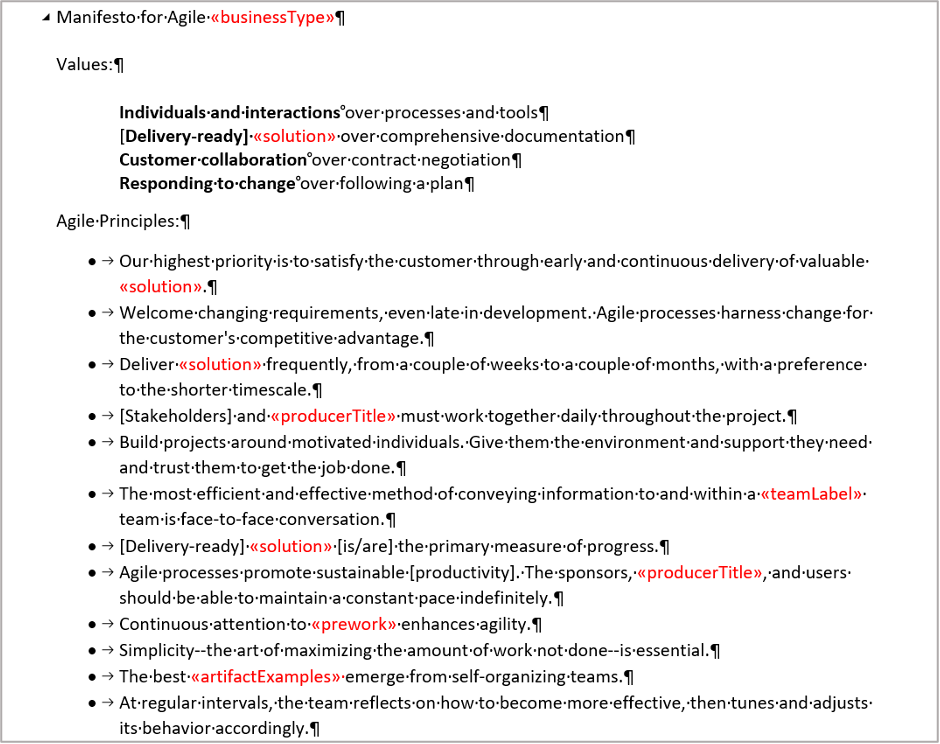In 2001, a group of men from various software development companies met to discuss and document an alternative approach to “…documentation driven, heavyweight software development processes…” This group came up with four values and twelve principles that, when practiced, would provide people a better way of developing software. They called their list of values and principles “The Agile Manifesto.”
Although Agile originated in the IT industry, and is still often thought of an IT-only methodology, it applies beautifully to all kinds of work beyond IT. I often have students attend my Agile training who don’t know the first thing about software development but are excited to start applying the Agile concepts and practices to their type of work after the first day of training.
To illustrate the wider applicability of Agile, I modified Agile Manifesto values and principles below by parameterizing the software-specific words. (I also changed a couple of constant values for clarity, as indicated with brackets)

Then, I took a stab at creating variables for other types of work I thought could benefit from Agile:

For example, here’s what the Agile Manifesto may look like when applying marketing variables:
Manifesto for Agile Marketing
Values:
Individuals and interactions over processes and tools
[Delivery-ready] marketing strategies over comprehensive documentation
Customer collaboration over contract negotiation
Responding to change over following a plan
Agile Principles:
- Our highest priority is to satisfy the customer through early and continuous delivery of valuable marketing strategies.
- Welcome changing requirements, even late in development. Agile processes harness change for the customer’s competitive advantage.
- Deliver marketing strategies frequently, from a couple of weeks to a couple of months, with a preference to the shorter timescale.
- [Stakeholders] and consultants must work together daily throughout the project.
- Build projects around motivated individuals. Give them the environment and support they need and trust them to get the job done.
- The most efficient and effective method of conveying information to and within a marketing team is face-to-face conversation.
- [Delivery-ready] marketing strategies [is/are] the primary measure of progress.
- Agile processes promote sustainable [productivity]. The sponsors, consultants, and users should be able to maintain a constant pace indefinitely.
- Continuous attention to excellent market research and brand definition enhances agility.
- Simplicity–the art of maximizing the amount of work not done–is essential.
- The best campaigns, promotions, and digital marketing emerge from self-organizing teams.
- At regular intervals, the team reflects on how to become more effective, then tunes and adjusts its behavior accordingly.
With a little bit of modification, most, if not all, of the values and principles will align to most types of knowledge work.
What About Agile Frameworks/Methods?
Scrum
Scrum is the most widely used Agile framework. It is a light-weight process that organizations can implement to help them manage their work. It contains specific directions on team structure and roles, events, artifacts, and rules. The first page of the current Scrum Guide makes it clear that Scrum isn’t just for IT:
“Scrum (n): A framework within which people can address complex adaptive problems, while productively and creatively delivering products of the highest possible value.”
Scrum has highly structured rules. It requires dedicated, small, cross-functional teams. It also requires work to be planned, executed and completed incrementally and iteratively in consistent timeboxes (1-4 weeks), called sprints. There are five required events that take place throughout each sprint. These strict, but minimal, rules, when followed, guide the team to shorter delivery cycles, higher quality, and better communication. These rules benefit organizations that work on complex, often-changing problems, such as education, government, and product development. I know several people who used Scrum to plan their weddings. And if anything is fraught with complex adaptive problems, it’s wedding planning!
Kanban
The Kanban method is a very simple set of principles and practices that provide a system for managing work… any type of work. Kanban includes practices such as visualizing all the work, limiting work in progress, managing flow, and making policies explicit. Kanban doesn’t have the concept of sprints. Instead, work continually flows through your system. Work is optimized by continually balancing demand and capability, eliminating bottlenecks and reducing the cost of context switching. Productivity in Kanban is measured by lead time (the time it takes to start and complete work) and the goal is to continually strive to minimize lead time in a sustainable, humane way.
Scrum is good when:
- Work is complex and adaptive
- You can design small, cross-functional, dedicated teams
- You can consistently plan work in timeboxes (1 – 4 weeks) and rarely having to change committed scope
- you need a prescriptive structure to ensure your org is following effective Agile practices
Kanban is good when:
- Priorities are constantly changing (e.g., help desk work)
- You have little ability to modify team size and capability
- Your teams and the work you do doesn’t require a highly structured framework
- You need a flexible model with clear, objective, metrics.
While any Agile proponent out there will insist Agile can be effectively used in all kinds of work, it’s still pretty rare to see concrete Agile examples using work other than software development. It’s high time we (including me!) start updating our training material and Agile books, blogs and YouTube’s to be more inclusive of work outside IT. We can’t keep this amazing tool in IT only. Let’s share it with everyone. Start by booking your training today!